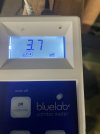I've mentioned that i'm setting up a large tank this spring - i will use pure ro wter but i'm unsure if it matters if the peat is under the substrate or in the filter. My hope is i can put it in the filter (in filter bag) so it is easy to replace as needed.
Conversely is there a difference between ro unit that say 'ro' and those that say 'rodi'; is ro implying di ? Again any suggestion around optimization for this application. As for ro unit i'm looking at:

 nilocg.com
(it has good volume per day and effiicency is stated 1:1 - he says this is the unit he uses for his fertlizer and claims it is 99%)
nilocg.com
(it has good volume per day and effiicency is stated 1:1 - he says this is the unit he uses for his fertlizer and claims it is 99%)
Another unit i found is

 spectrapure.com
spectrapure.com
But it is quite expensive (it states di and is 1:1 waste but very costly).
-
Given the volume of water required I need at least 200 gpd and want waste no worse than 1:1 - for water change i'll probably have to use acid to lower the new water ph to the tank's ph and the peat would be use more for stability with leaves of course.
Conversely is there a difference between ro unit that say 'ro' and those that say 'rodi'; is ro implying di ? Again any suggestion around optimization for this application. As for ro unit i'm looking at:

AICKSN 5 STAGE REVERSE OSMOSIS (600 GPD)
Certification: CE, TUV,RoHS Power (W): 28, Voltage (V): 220 Working pressure: 0.1-0.4Mpa Working Temperature: 5-38°C Inlet/outlet size: 1/4″ Features: Low pressure RO membrane, pure water, rejection Rate 1:1 with adjustable valve. Stable flow rate RO membrane, long lifespan Optional for...
 nilocg.com
nilocg.com
Another unit i found is

SpectraPure® MaxCap ® 1:1 Ultra High Efficiency 200GPD RO/DI System - MC-RODI-200UHE-10HC
SpectraPure MaxCap 200GPD RO/DI System combines our innovative UHE 1:1 Technology with our MaxCap Technology to create a system that produces High Quality, Ultra Pure Water while reducing consumption and waste by 4-10x times over other systems! Manufactured in the US, see why SpectraPure is the...
 spectrapure.com
spectrapure.com
But it is quite expensive (it states di and is 1:1 waste but very costly).
-
Given the volume of water required I need at least 200 gpd and want waste no worse than 1:1 - for water change i'll probably have to use acid to lower the new water ph to the tank's ph and the peat would be use more for stability with leaves of course.

